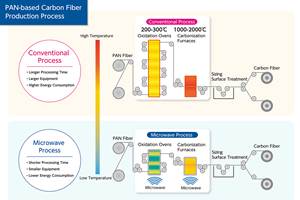IsoTruss receives USDA funding award for rural broadband project
Resilient composite mobile cell sites to provide more sustainable and versatile network access across rural locations.

Photo Credit: IsoTruss Inc.
IsoTruss Inc. (Springville, Utah, U.S.), an engineering, design, and manufacturing services provider, has received a funding award for $124,000 from the U.S. Department of Agriculture (USDA). In this rural broadband project, the enterprise expects to use its patented geometry to create a lightweight, composite space-saving mobile cell site to provide temporary network coverage, one that can be assembled and disassembled quickly, without additional equipment. The planned IsoTruss mobile cell site will save space, weigh less and last longer than current options.
“We are committed to help solve the digital divide in network coverage for nearly a quarter of rural Americans who are without broadband access,” Nathan D. Rich, CEO of IsoTruss Inc., says. “Expanding network coverage to them will improve rural community economies and quality of life, while providing access to important services such as telehealth, distance learning, ecommerce and remote work opportunities.
IsoTruss Inc. designs and manufactures patented composite lattice structures that are said to reduce weight by 12 times compared to steel structures, without compromising strength. These structures have been successfully applied to rural telecom towers because of their reduced weight and significantly lower installation and maintenance costs. A benefit of the mobile cell site is that it should be able to be transported with a light-duty truck, which enables greater access to rural and remote locations, and saves gas, which reduces emissions. This is the enterprise’s second funding award from the USDA.
IsoTruss lattice cell towers, fabricated with corrosion-resistant composites and using patented geometry, offer flexibility and modularity in structural design as well as optimized wind resistance, according to the company. IsoTruss towers are engineered and tested to last at least five times longer than steel towers, which need to be replaced more often due to corrosion and other environmental factors. Consequently, the total cost of ownership (TCO) is lower, and on the environmental side, carbon dioxide emissions are reduced by 70% or more over the tower’s lifespan.
“Lightweight, mobile cell sites can also provide network access quickly during natural disasters when existing networks are damaged. The space and weight savings of the IsoTruss will allow these mobile cell sites better transport and assembly in disaster-stricken areas,” Cromwell Wong, COO, IsoTruss Inc. adds. “Plus, our sustainable lattice tower infrastructure reduces CO2 emissions based on weight, material and design, making our cell towers very competitive with steel towers.”
Each IsoTruss cell tower is designed and manufactured to meet the firm’s own rigorous design and production standards, various local, state and federal regulations and Telecommunications Industry Association (TIA) and American Association of State Highway and Transportation Officials (AASHTO) standards.
Since 2019, IsoTruss Inc. has received multiple funding awards totaling nearly $1 million combined from both the U.S. Department of Agriculture (USDA), to support expansion of rural broadband, and the Environmental Protection Agency (EPA), for research and development of a reinforced concrete foundation for telecom towers to increase resiliency to natural disasters.
With a global portfolio of more than thirty patented and patent-pending structural and composite material designs that protect not only the configurations but also the manufacturing processes, IsoTruss is committed to building the sustainable infrastructure of the future through innovative solutions in engineering, design, manufacturing and construction.
The company is an active member of the Institute of Advanced Composites Manufacturing Innovation (IAMCI, Knoxville, Tenn., U.S.), a Manufacturing USA institute established by the U.S. Department of Energy (DOE). IACMI’s mission is to accelerate advanced composite design, manufacturing, technical innovation and workforce solutions to enable a cleaner and more sustainable, more secure and more competitive U.S. economy.
Related Content
CirculinQ: Glass fiber, recycled plastic turn paving into climate solutions
Durable, modular paving system from recycled composite filters, collects, infiltrates stormwater to reduce flooding and recharge local aquifers.
Read MoreASCEND program update: Designing next-gen, high-rate auto and aerospace composites
GKN Aerospace, McLaren Automotive and U.K.-based partners share goals and progress aiming at high-rate, Industry 4.0-enabled, sustainable materials and processes.
Read MoreMicrowave heating for more sustainable carbon fiber
Skeptics say it won’t work — Osaka-based Microwave Chemical Co. says it already has — and continues to advance its simulation-based technology to slash energy use and emissions in manufacturing.
Read MoreRecycling hydrogen tanks to produce automotive structural components
Voith Composites and partners develop recycling solutions for hydrogen storage tanks and manufacturing methods to produce automotive parts from the recycled materials.
Read MoreRead Next
Isotruss carbon fiber cell towers support global demand for 5G telecom rollout
Isotruss ramps up development of composite lattice cell towers which are twelve times stronger than steel towers, 1/12 their weight and reduce carbon emissions by 70%.
Read MoreCovestro unveils thermoplastic polyurethane material for augmented 5G signal transmission
Desmopan 7000 TPU is characterized by high transparency for 5G frequencies for reduced signal loss, making it suitable for applications such as cell phones covers.
Read More“Structured air” TPS safeguards composite structures
Powered by an 85% air/15% pure polyimide aerogel, Blueshift’s novel material system protects structures during transient thermal events from -200°C to beyond 2400°C for rockets, battery boxes and more.
Read More
























